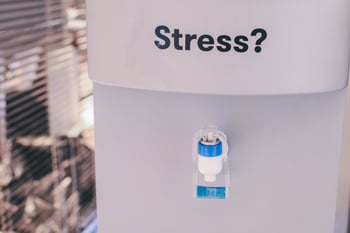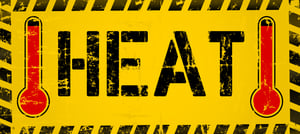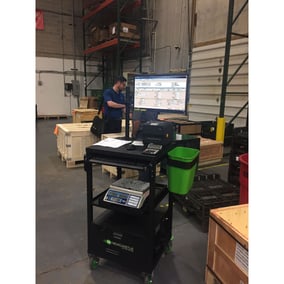
When the temperatures start to rise in the summer, so do the dangers to your warehouse staff. The U.S. experienced its hottest June on record in 2021, and there were over 31 million people subjected to heat advisories or excessive heat warnings in one month alone.
When it’s over 100 degrees outside, you can bet that the temperatures are much higher inside a warehouse or distribution center. That’s why it’s vital that fulfillment centers, warehouses, and 3rd party logistics providers understand the dangers of heat stress and take the proper steps to avoid it.
What is Heat Stress?
Heat-related stress can cause any number of health issues. Even worse, it can be deadly. The CDC completed a 10-year study on heat-related illnesses in the U.S., finding that there was an average of 618 deaths per year. During one extreme heatwave in 2012, OSHA recorded over 4,100 heat-related worker illnesses.
When the human body is exposed to high temperatures, its internal temperature rises. If steps aren’t taken to lower body temperature, a worker can suffer from one of four different types of heat stress:
Heat Cramps
Heat cramps are muscle spasms that occur due to low levels of water and salt in the body. Even if a worker has been hydrating, it’s still possible to experience heat cramps because the salt levels in their body haven’t been replenished because of the salt being depleted through sweat.
Heat cramps often occur in the legs, arms, or abdomen. The best way to prevent or treat heat cramps is to:
- Drink an electrolyte beverage or water every 15-20 minutes
- Move out of the heat whenever possible
- Apply a wet, cool compress to the cramped area
It’s important to seek medical attention if cramps don’t subside within an hour of taking action.
Heat Exhaustion
Heat exhaustion is one of the most common types of heat-related illnesses. It can also be quite serious if not addressed quickly. The condition is caused by the extreme depletion of salt and water in the body. Symptoms of heat exhaustion include fatigue, weakness, headache, and nausea. Workers might also experience excessive sweating, elevated body temperature, and decreased urine output.
If heat stroke isn’t treated quickly and appropriately, it could lead to stroke. Treatment for heat stroke includes:

- Drink plenty of water or a drink with electrolytes
- Lie down with a cool compress on the neck, head, and face
- Loosen clothing and remove shoes and socks
- Fan air towards the body to help lower its core temperature
If a worker doesn’t show improvement within 30 minutes, they should be transported to a medical facility for additional treatment.
Heat Syncope
Heat syncope is a heat-related illness resulting in a person’s loss of consciousness or collapse due to excessive heat. A worker experiencing this may not experience an increase in body temperature, however.
Workers who are exposed to a humid, warm environment may be experiencing heat syncope if they experience lightheadedness from prolonged standing or standing up too quickly. Other symptoms include dizziness and fainting. Those who experience heat syncope should rest in a cool area and drink water or an electrolyte beverage.
Heat Stroke
Heatstroke is the most serious type of heat-related illness a worker can suffer. It is typically caused by a combination of heat exposure and exertion or heavy physical activity. The body is unable to regulate its internal temperature, which can soar well past 105 degrees quickly. If not regulated promptly, this can lead to coma, brain damage, and even death.

If a worker is suffering from heatstroke, call emergency services immediately. While you wait for them to arrive:
- Move the person to a cool or shaded area
- Try to cool them down with water, ice, and fans
- Remove or loosen any restricting clothing
The physical impact of heat stress can be devastating. But employers should also consider the idea that people who are uncomfortable and sick aren’t going to be as productive as those who feel well.
Fatigue is a serious issue. BIG ASS Fans (yes, that’s a real company) released a study showing that there is a significant drop in production levels as the effective temperature rises. When these conditions are present, employers can expect to see higher absenteeism rates, lower morale, and a decline in productivity.
6 Tips for Avoiding Heat Stress in the Warehouse
OSHA’s Heat Illness Prevention campaign, launched a decade ago, educates workers and employers on the dangers of extreme heat exposure. It emphasizes the need to protect workers and address heat-related illnesses quickly. Here are some ways you can address heat stress in your warehouse.
1. Use Proper Ventilation
Proper airflow is essential to move hot, stagnant air. You can start by making sure your warehouse has the right duct and exhaust system to allow cool air in and stale air to escape. Use high-velocity fans to cool off large areas where you know the heat will be a concern.
2. Mark Hot Areas

Warehouses often have a lot of heavy equipment that can generate heat. Whenever possible, insulate that equipment so that it produces less heat and minimizes danger to your workers. If workers must be in proximity to these areas, mark them clearly, so they are aware of the additional hazards.
3. Provide Breaks and Water
Have an air-conditioned break area where employees can escape the heat and recharge. Also, one of the best ways to prevent heat-related illnesses is through proper hydration. Furnish workers with a fresh supply of cold drinking water to keep them well hydrated.
4. Encourage a Healthy Workforce
Since healthy workers have a lower risk of succumbing to heat-related illnesses, encourage staff to take care of themselves. Give workers incentives to pursue healthy lifestyles and diets while also accomodating those with limitations.
5. Automate Strenuous Work
There are many benefits to automation. Aside from optimizing your warehouse operations, automation can also protect workers from the stress related to heatstroke. Some of the automation solutions you can implement include:

- Electric Pallet Jacks - Use electric pallet jackets to reduce the stress on workers.
- Voice Collection - Have workers do some tasks via voice collection to cut down on repetitive motion and unnecessary trips inside a hot warehouse.
- Mobile Workstations - Improve worker safety and comfort with mobile workstations. This integrated laptop, monitor, scanner, and printer can move around the floor with the worker and reduce repetitive trips.
6. Educate Your Staff
All warehouse workers and management should be trained to recognize the early signs of heat-related illness. The quicker you can take preventative measures in hot working conditions, the better chance you have of preventing potentially serious incidents.
At the end of another hot day, investing in the right processes, equipment, and engineering controls, are far less costly than suffering the potential revenue losses that come from lower productivity or costly employee injuries related to heat stress. And, it’s just the right thing to do for a business that values the health and safety of its workers.